Aaaah, the German Krampus Legend. It somehow seems fitting, if not stereotyping, that only the Germans would create a Christmas demon designed to terrorize your children into behaving and “being good” vs just letting Jolly Ol’ St. Nick check a list for “Naughty or Nice” names.
The reality is that like so many things in Germany, the Krampus legend is steeped in traditions that go back all the way to the 12th century. To truly understand and appreciate this bizarre, hair rasing (and let’s be honest, actually pretty fun) folklore, we’ve got to dig more into the history of Krampus. Luckily for you, I’ve lived in Bavaria for almost a decade now, where most of the Krampus festivities take place, and am only slightly obsessed with going to Krampus Fests locally here in Germany because of how thrilling they are!
So, let’s deep dive into the origin of Krampus, who he is (and who he is NOT), and how Germans “celebrate” Krampus even today.
Warning: This article is long (but FULL of tidbits and insider info you’ll only find here on WIG). But I get it, we’re all busy.
Here’s the TL;DR version:
- Krampus is traditionally celebrated in Southern Bavaria and in Austria
- Krampus is half goat/ half devil
- He is NOT a “Bad” or “Evil Santa”- he is his own, terrifying creature who ACCOMPANYS St. Niklaus (not Santa)
- Why yes, Krampus loves to steal naughty children to the underworld and eat them (or at the very least beat them with a stick)
- Of course Bavarians ACTUALLY teach the Legend of Krampus to children still today… naturlich
- Krampusnacht is traditionally on December 5th each year
Limited Time- Free Krampus Tshirt Giveaway!
a Rafflecopter giveawayYou'll Find In This Article:
Who Is Krampus?
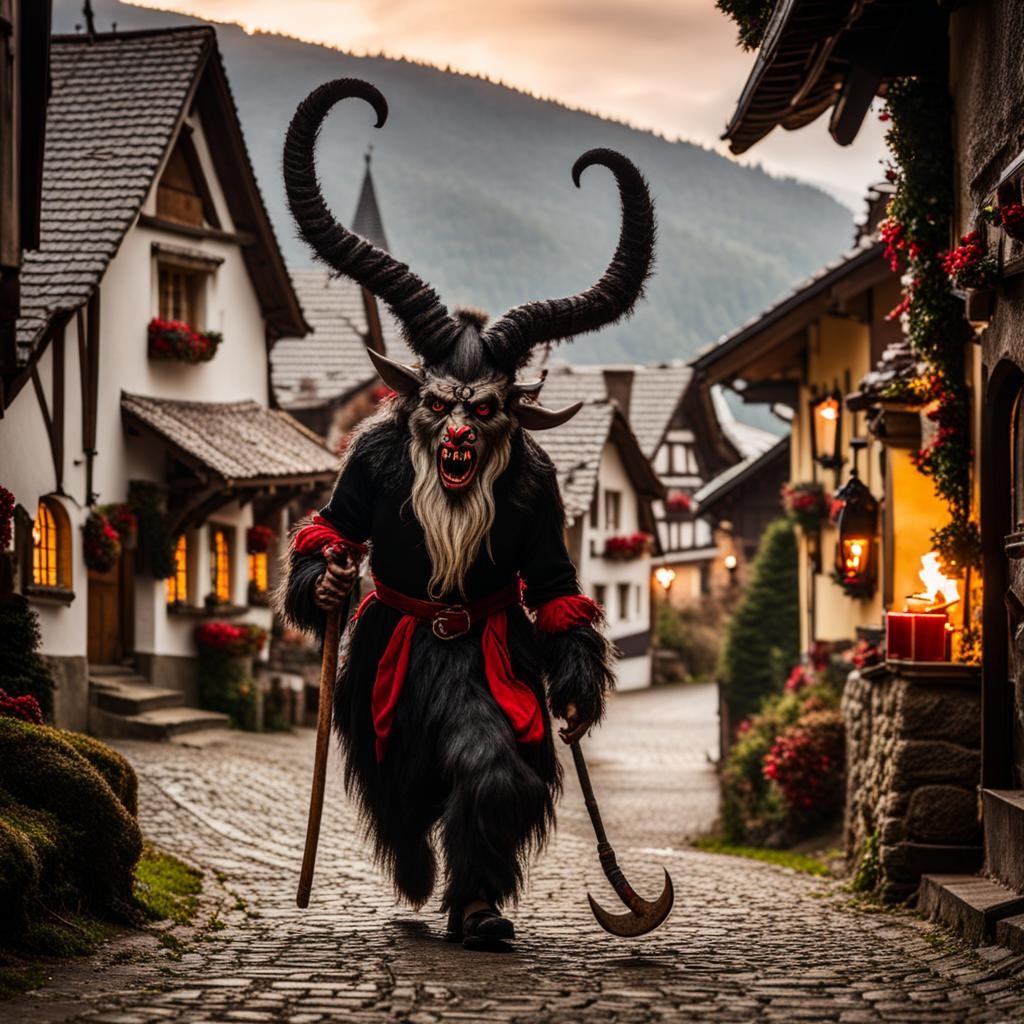
Or maybe the better question is, “WHAT is Krampus!?”
If you don’t know the origin of Krampus yet, go make yourself a Glühwein and then buckle up those Lederhosen, because you’ll find yourself saying, “WHAT IN THE WORLD!?” at least a few times.
So, who is Krampus? You might have heard about an “Evil Santa Claus” but that isn’t true at all. A “Christmas Devil” would be much more fitting to describe Krampus. After all, in Germany, Krampus is literally seen as half goat/ half devil. While the piercing sharp horns, matted fur, and hooved feet sound innocent enough, his contrasting and menacing eyes, grotesque teeth, and a pointed tale tell us that this is a creature from the depths of hell.
And when Krampus comes out in the deep dark nights of winter, you better watch out, you better not shout….because he’s gonna whoop you! Oh, and he’ll probably also steal your naughty children to his underground lair and eat them.
Like I said, “Aaaaaaah, Germany!” Gotta love it!!!
Please note that some articles contain links that earn me a small commission at no extra cost to you.
As absolutely hilarious as this Krampus song is, it actually gives a pretty accurate “description” of the German/Austrian Krampus story. And it legit made me laugh out loud.
I think my favorite part of this Krampus Song is the Krampus correcting the American Cowboy on his pronunciation of “Krampus,” literally giving phonetic lessons on how to say it! (Oh how very German of him!!!) But also, it’s pretty funny hearing “He beats naughty children with a stick!” sung in a cheery Christmas Carol sort of happy tune. I’m definitely adding this to my Ugly Sweater playlist this year!
Get Your Own Krampus Ugly Sweater/ Shirt Here
Krampus is NOT the Anti Santa
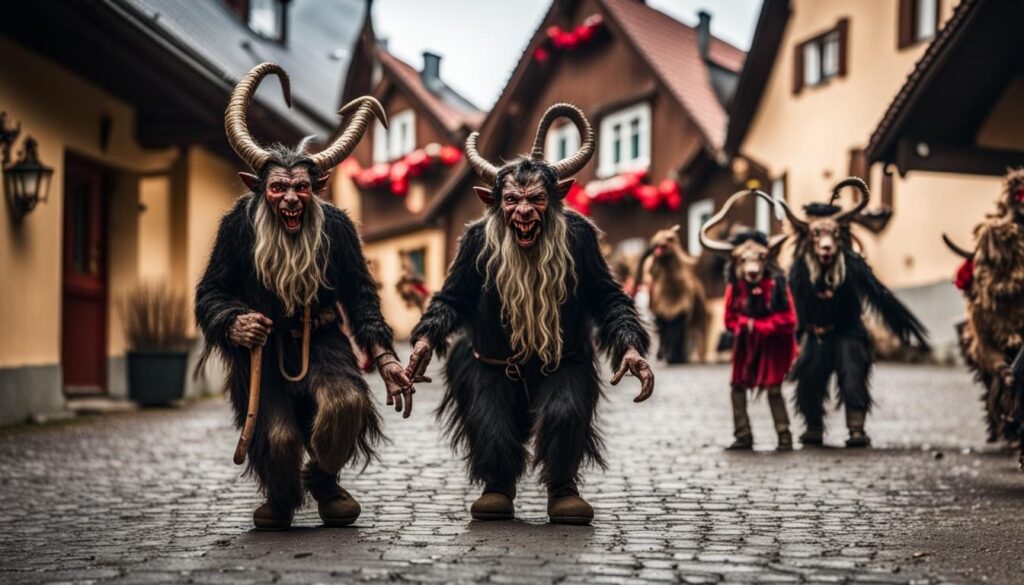
Anyone who calls Krampus Santa’s Evil counterpart is doing the Krampus story (and German folklore) a huge disservice.
While I want to dive into the actual history in a minute, for now, you need to know that Krampus is actually St. Niklaus’ counterpart (not Santa!). I know what you are thinking,
“But LeAnna! Santa and St. Nick ARE the same white bearded dude!” Nope. Not in Germany!
Remember, the big fat Santa Clause most Americans think of (actually created in the 1930s by Coca Cola) is much different from the real person, St. Nicholas. After all, according to the St Nicholas Center, Nicholas, the Archbishop of Myra (Turkey), who later became a saint, is merely the “historical figure” who inspired modern-day “Santa Claus.”
In Germany, “Santa Clause” (at least the fat guy with rosy cheeks busting out of a red suit) doesn’t exist (There is the Weihnachtsmann who is arguably the closest version of “Santa Claus” but that’s another article to be written). Instead, they still celebrate the actual “St. Nikolaus”, still seen in his Bishoply form and doing what he supposedly did 1700s years ago- giving gifts to “those in need.” HOWEVER, he doesn’t even come around ON Christmas!!!! Buuut, more on that in a moment as well!
So, to bring this all full circle: St. Nik (in Germany) rewards all the good little boys and girls in early December while Krampus….well, he eats the flesh off of anyone naughty and whips those who have misbehaved.
German Christmas Timeline of Events
In order to understand that Krampus is not Santa, it might be helpful to understand some of the German Christmas Traditions and important days surrounding the holiday. For the sake of brevity though (ha! me? short and to the point!?) I’m going to give you a very brief TL;DR version for now.
December 6th St. Niklaus Day: I won’t get into that whole tradition here since it is its own topic as well, but as I mentioned earlier, St. Niklaus typically isn’t who comes on Christmas Day with gifts. Instead, on the feast day of St. Nick (December 5th), he goes around placing a few sweets, usually some oranges or apples, and “gold coins” (now in the form of chocolates) in children’s boots, just like he “did” in real life in Turkey.
December 5th Krampusnacht: And here enters the “Bad Santa” misconception. Think of Krampus more as St. Nick’s counterpart, NOT an “Evil Santa” version of him. The night before St. Nick comes around, Krampus cleans house. While St. Nick is preparing to reward all the “Good little boys and girls” Krampus crashes in to steal away any kids that haven’t been on their best behavior!
And what exactly does Krampus do to children?? Oh, you know….he snatches up any naughty kids and steals them away to his lair. That’s where he then EATS them, or “simply” just gives them a good beating with a hard, wooden rod!!!!!!
Yup. Germans take the whole “If you’re naughty, you’ll get a lump of coal” thing to a whooooole new level!
But, since “St. Nicholas” and “Santa” are often intertwined (in American culture at least) we can now all see the misunderstandings.
However, in true, traditional German Krampus festivals, St. Nicklaus and Krampus are typically seen side by side, together, almost working in tandem. St. Nick is often needed to “wrangle” in the wilding and keep him in line, or at the very least, ensure he is chained up for safe keeping.
Important Note: Krampus is not “celebrated” all over Germany. In fact, he’s mostly “seen” only in Bavaria, and even then, he’s not super common until the southern parts of Bavaria.
The History of Krampus
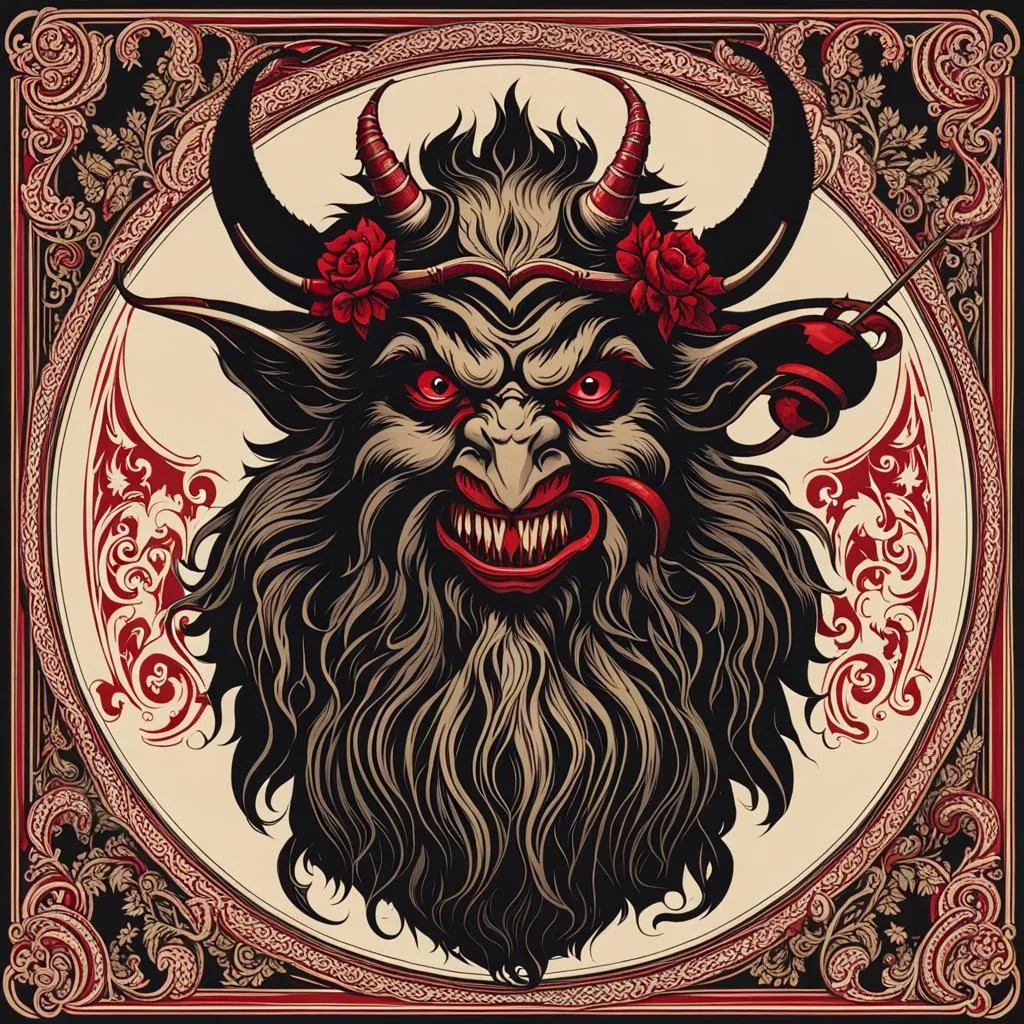
Ok, so, we get it. Krampus ain’t playin’. But how did the Krampus folklore even start? Where is Krampus from? I mean… Who was sitting in bed one night thinking, “What’s the best way to get my kids to behave? Oh, I know….I’ll have a devil goat threaten to kidnap and eat them!”
The reality is, that the Krampus myth goes so far back in time, that nobody actually knows the real origin story.
Most believe he originated in what is today’s Austro-Bavarian region (Salzburgerland) which includes Berchtesgaden (Germany), Salzburg (Austria), and St. Johann im Pongau (Austria) among other Alpine towns. However, he is especially popular in the South Tirol region of Austria as well.
While most sources say that Krampus originated from pagan traditions, some believe that’s not true at all. If you ask lil’ ol me, I think it’s a little bit of this and a little bit of that. After all, we all pretty much know that so many of today’s traditions are often rooted somewhere in an ancient pagan ritual, belief, or story.
The Catholic Influence
However, if you really study Krampus, not much of the origin can be historically connected to a specific pagan belief or tradition (that we know of at least). Instead, it’s pretty obvious that there was the classic Catholic bait and switch! (However, I will strongly argue that the Perchta traditions in Germany, which is often confused with Krampus IS highly tied to pagan winter solstice rituals, but we can talk about Perchta below).
I think by this point in time, we all know that Catholics are pretty notorious for taking pagan beliefs and either demonizing them to pull people away from those belief systems or just flat out “stealing” pagan traditions and holidays to fit their own narrative. So, it’s actually no surprise that the original Krampus legend probably emerged in this same way.
And if you look at Catholic history, the real Saint Nicholaus (of Myra) is often credited with being an exorcist, so it would make sense that the Catholics saw this as an opportunity to make the two a formidable pair! So, while Germans often get a bad rep for being strict, nobody does “I’ll guilt you into behaving” like Catholics (believe me, I was raised Catholic!) I guess put the two together and BAM! You’ve got yourself a Krampus!!!
Medieval Times
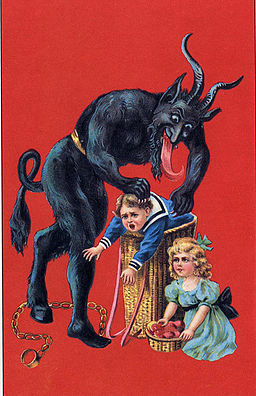
Let’s travel back to the 1100s when some of the first recorded reports of Krampus have been found. What else was happening in the 1100s in Europe? Oh, you know…just that major thing called the Medieval Inquisition. And what was a huge part of that? You guessed it- the Catholic church was in its heyday of “combatting heresy” (Aka shutting down other/ pagan belief systems).
And this all makes sense to how the Krampus story began! The evolution of what Krampus looks like has changed over time (as well as is influenced by different regions). However, if you look at some of the very first Krampus images, he looks almost identical to the medieval depictions of what Catholics believe the Devil himself looked like at that time! The images of the devil who is bound with chains, has long horns, a slithering tongue, etc all originate from the medieval period.
So it’s highly possible Krampus came to be from the medieval beliefs on who and what the Devil was!
What Does Krampus Look Like?
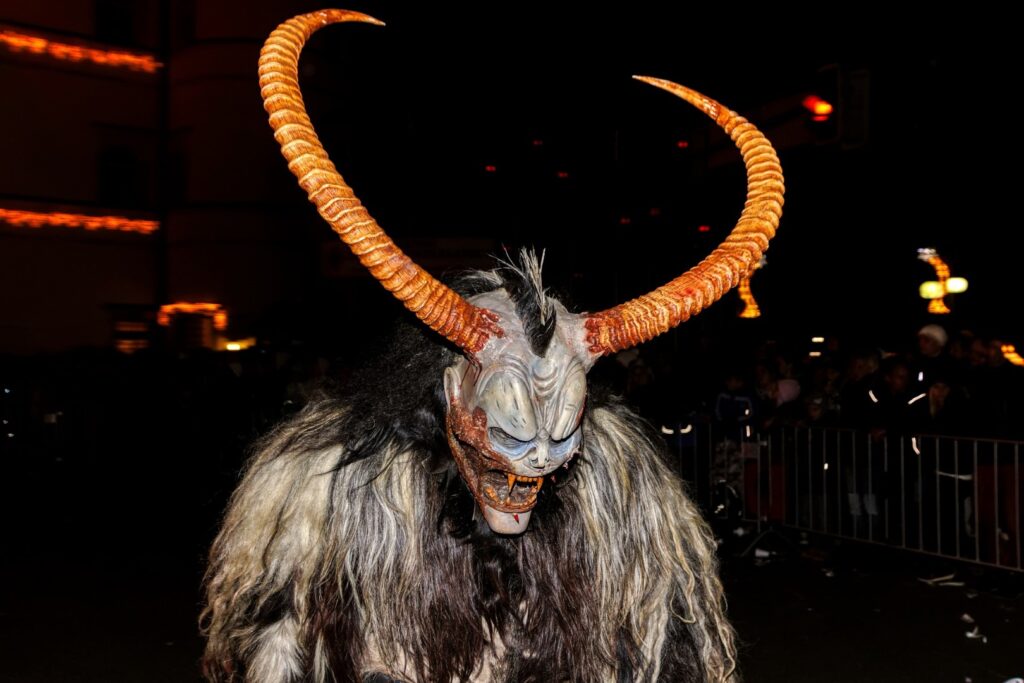
The Krampus creature is horrifying at best. Its body is covered in matted, coarse, dark fur that seems to bristle with malevolence. While parts of his body resemble a man, his claw like hands that are ready to grab unsuspecting victims and hooved feet reveal he is anything but human.
His face tells a tale of terror. With eyes blazing, he peers around for his next fleshly meal, which you can inevitably see the leftovers hanging from his jagged, sharp teeth. He flicks out his tongue, grotesquely long and forked in a taunt.
Krampus also bears the weight of chains and shackles, or a clamoring bell, which is worn from his tattered, dark robes that often billow behind him as he prowls the streets.
However, since about the 1800s, the most popular drawn depictions almost always show Krampus as being a black, furry beast. The bottom half of his body is like a goat, with hooves and he is almost always seen shackled up in chains in that version. He has long pointy ears and a rolling red tongue that can reach out and grab children. He is typically holding a pitchfork and birch branches for whipping in these pictures as well.
What Does a Krampus Look Like at a Krampus Festival IN Germany?
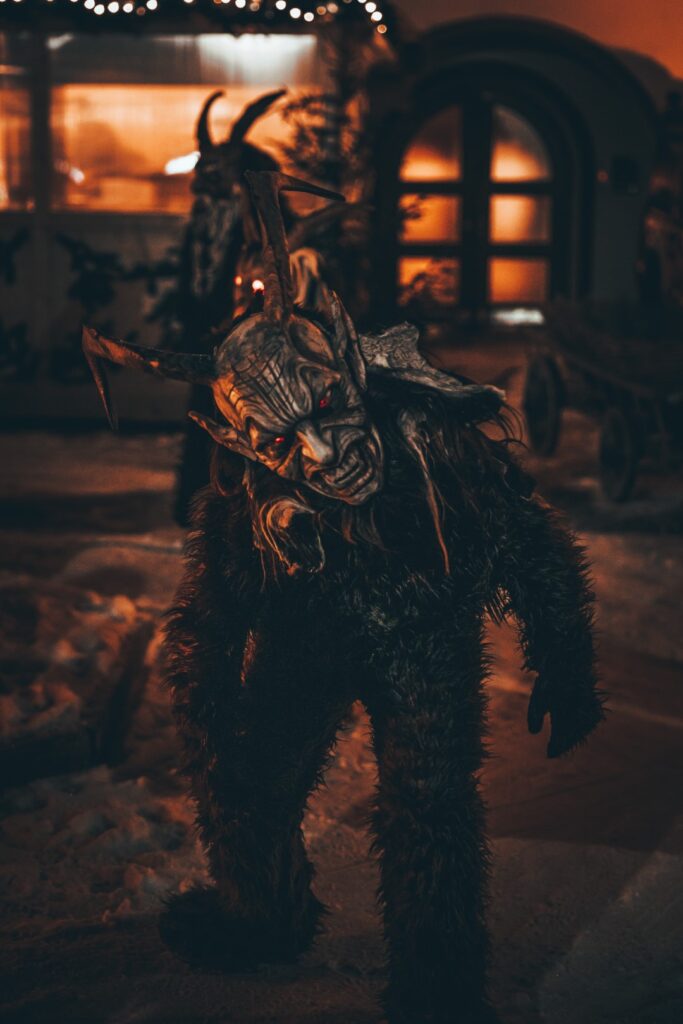
The above flowery description of Krampus is great for night time ghost stories but a lot of that is still pretty true for what a Krampus looks like “in real life,” depending on where in Germany or Austria you are (or what Krampus Festival you’re at). Krampus today may take a few different forms though and what he looks like also may depend on the exact KIND of Krampus you see, since there are many different iterations of the Christmas Devil.
At a Krampus Fest or Krampuslauf (run), the most impressive and popular part of his look is the Krampus Mask. In a truly traditional festival, these are typically pain stakingly, hand carved, demonic looking faces. Most modern day Krampus costumes will have the long or twisting horns and huge fangs. Some have unusually long, pointy noises and/or chins (especially so for the Perchta masks).
The costumes are elaborate and fully covered in fur with shoes that will resemble the hooves. Some will have chains while others have huge, giant alpine cow bells. The ones that have chains are believed to be devilish like beasts, whereas the ones with ginormous bells actually are often “Percthen” which traditionally use their bells to drive away evil spirits.
In other areas, such as Berchtesgaden, instead of fur, the Krampus costume may be made of straw, but this is known more as the “Buttnmandl”
Is Krampus Real or Fake (and do Germans actually believe in Krampus?)
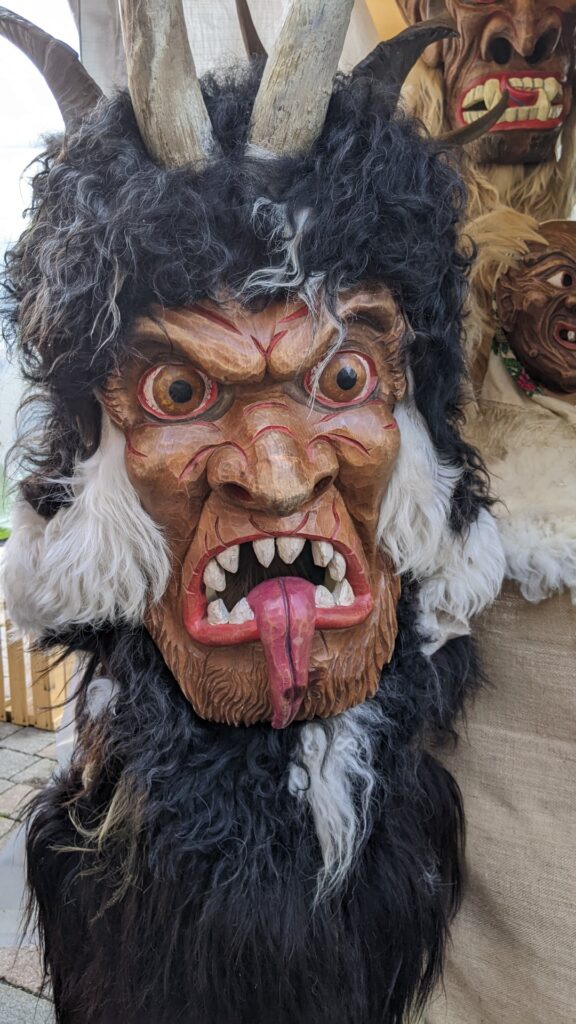
No. Krampus is not real. Yes, Germans (well, Southern Bavarians) actually do celebrate it!
But, oof…try explaining this to your (very sensitive) 6-year-old first grader who just learned about this in the “Erste Klass” (First grade) at his German school!
To be honest, since I didn’t grow up in Bavaria, I always thought the legend of Krampus was “just a thing.” Like something kids had heard of, maybe even caught a glance of at a Christmas Market, but not like full-on taught in the Bavarian culture. You know, something equivalent to how Americans “know” about Big Foot…it’s like we “just do” but that doesn’t mean we got a full on lesson in grade school from Mrs. Jones.
So when my son came home from first grade last year in a full panic asking me things like, “Where does the Krampus live?” or “Is Krampus still alive and if so, is he going to come get me in the middle of the night!?” I was like “Oh Oh. You need to calm down” (sorry, I’m currently in my “Am I a “Swiftie?” era)
I calmly replied, “Oh, yes, the story of Krampus….Did one of the kids tell you about him?”
Wide-eyed he said, “NO! We learned about it in Ethics Class!” (the equivalence to a “religion class”). I said, “Oh, a kid asked your teacher about it?” And he exclaimed, “NO! Frau H. had a whole lesson on it today!!”
Sooo uuuum yup! This apparently isn’t like a “Tooth Fairy” kind of made of story…Some Germans really DO teach their children about Krampus!!!
Krampus Culture Today
Today, Krampus is still celebrated in Germany (more on the amazing traditions surrounding Krampus Festivals in a moment) but what is fascinating is the craze of Krampus reaching new frenzied heights all over the rest of the world. With things like the Blockbuster Krampus Movie or hilarious Krampus Sweaters for Ugly Christmas Sweater parties, the Krampus legend is terrifying more and more people beyond the borders of Germany and Austria!
Krampus Celebrations In Germany
Most “Stereotypes” about Germany (Lederhosen clad men, pretzels so big they cover your whole face, real life fairytale castles that inspired Disney himself) are actually not stereotypes. All those things exist! Well, at least in Bavaria, they do! The reality is that when most people “Think of Germany” they often are envisioning Bavaria– why do you think I love living here so much!? (That’s not to say the rest of the country isn’t extremely worth your time, though!)
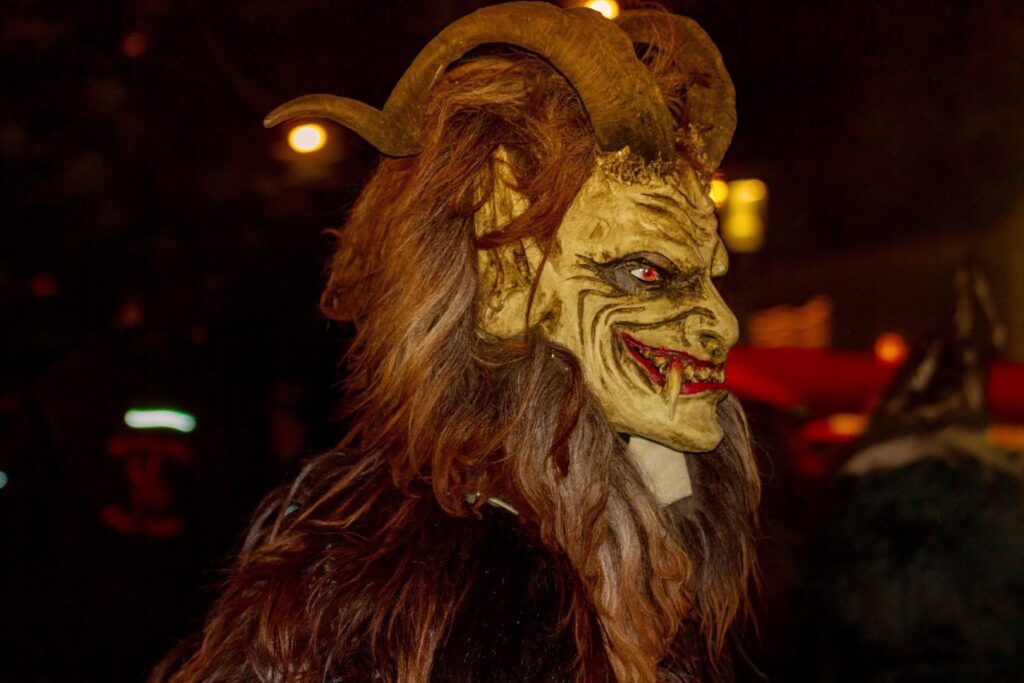
But it’s the same for the Krampus traditions. Not only is Krampus in Bavaria predominantly, but even more so, Krampus is most known in the Southern Alps of Germany and even more popular in Austria. In fact, the further North you get even in Bavaria, the more the legend changes, and some GERMANS don’t even really know much about the so-called “Germany Christmas Demon.”
Each region also may have its own take on Krampus (maybe a different name or even devilish entity, different times of the winter to celebrate it, etc) but generally speaking, the traditional Krampus still comes on December 5th and 6th to accompany St. Nicholaus for Krampus Day (more on this below).
A Bass or Pass of Krampus
What would even be the plural form of Krampus?
Krampi??? Krampusses???
Well, at least for regions that revere this long standing tradition in Germany and Austria, a group of Krampus is simply called a “Bass” (Pronounced like Baaahs) or “Pass.” A Bass/Pass is typically an official, local club and boys as young as 16 can be initiated into it. However, once he’s married (at least in some locations) then he’s booted out!!
“Gruß vom Krampus!” (Greetings from the Krampus!)
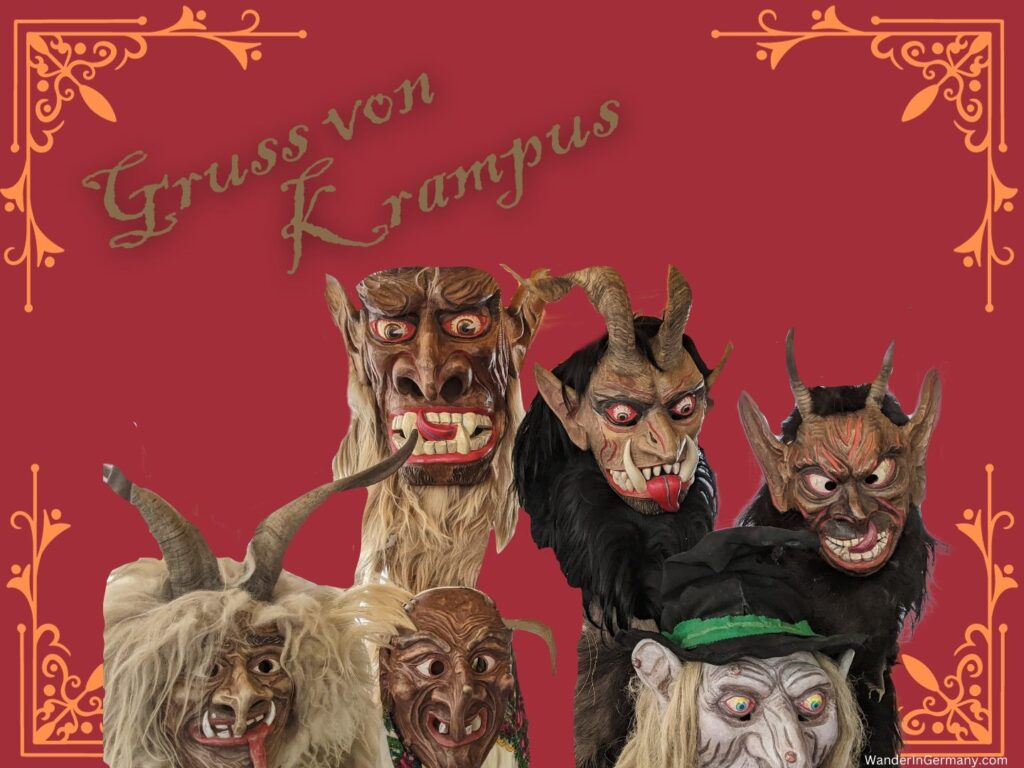
Today, the whole Krampus theme in other parts of the world has also become a marketing opportunity that is a mischievous way to counter the holly jolly cheer of Christmas. There are hilarious Krampus Sweaters, Krampus Ornaments, and even Christmas decor like a throw pillow with Krampus grabbing children.
You can also often find “original postcards” or Krampus art and pictures that say, “Gruß vom Krampus!” Think of it like the moment in The Shining Movie, where Jack Nicholson pokes his head through the door and says “Here’s Johnny”
Except this time, it’s a half devil- half goat man saying “Greetings! From Me, The Krampus!” but say it in a cynical tone of voice to really give people the creeps!
A Traditional German Krampusnacht
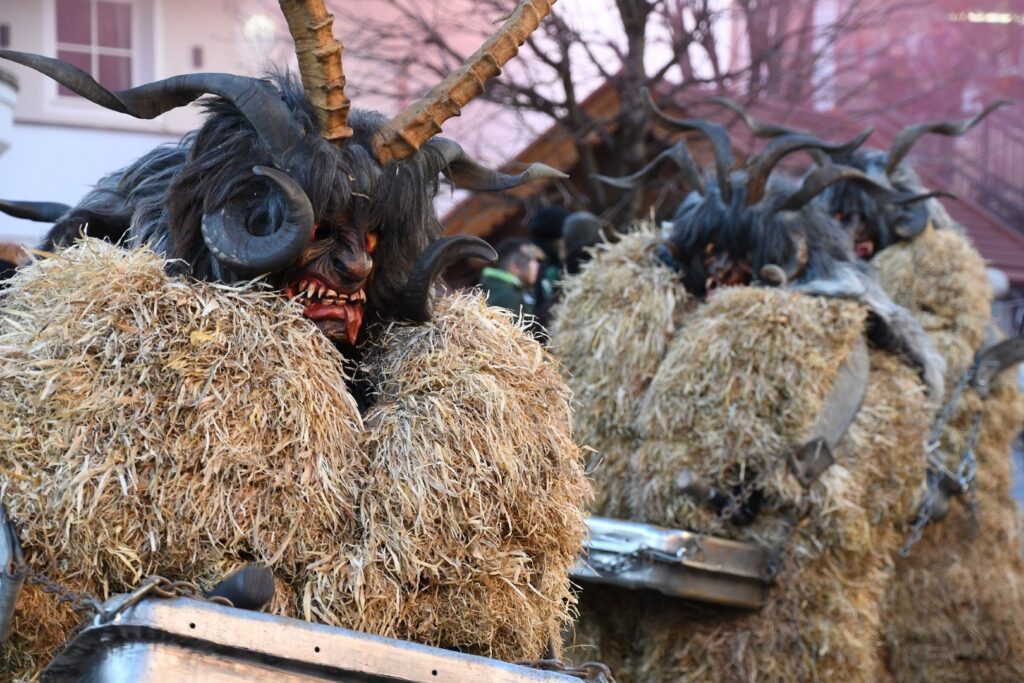
On Krampus Night (Again, Dec 5th and sometimes also on St Nicholas Day- Dec 6th), St. Nick will wander the Bavarian villages greeting the children, and right next to him, is mean ol’ Krampus.
Every town or village may have a different approach to this tradition. In the small village I first lived at in Bavaria, there was a local club/organization that would “terrorize” (in good jest) our small town Christmas Market crowd. At other markets, Krampus just kind of stomps around next to St. Nik causing a scene.
And then there are some towns that go all out and put on some of the best Krampus festivals! At these, there is often a parade where spectators can watch, but in some places, it’s not just a spectator sport! Be prepared to be chased and even possibly get whipped!
Pro Tip: At the big, rowdy Krampuslauf (Parades), Krampus will literally chase you! To make a happy Krampus, just offer him Schnapps!
German Krampusnacht Festivals
On Krampusnacht, you can often find Krampus running amok around the Christmas Markets in Bavaria and there are even a few special events dedicated just to a Krampuslauf (Krampus Parade). If you find yourself in Germany on Krampusnacht (December 5th and 6th) absolutely make an effort to go to one of these Krampus Parades in Germany! If you are here in Germany after Christmas, I also have several Perchtenlauf on that list as well which often are between Christmas and New Year’s Eve.
Different German Christmas Monsters
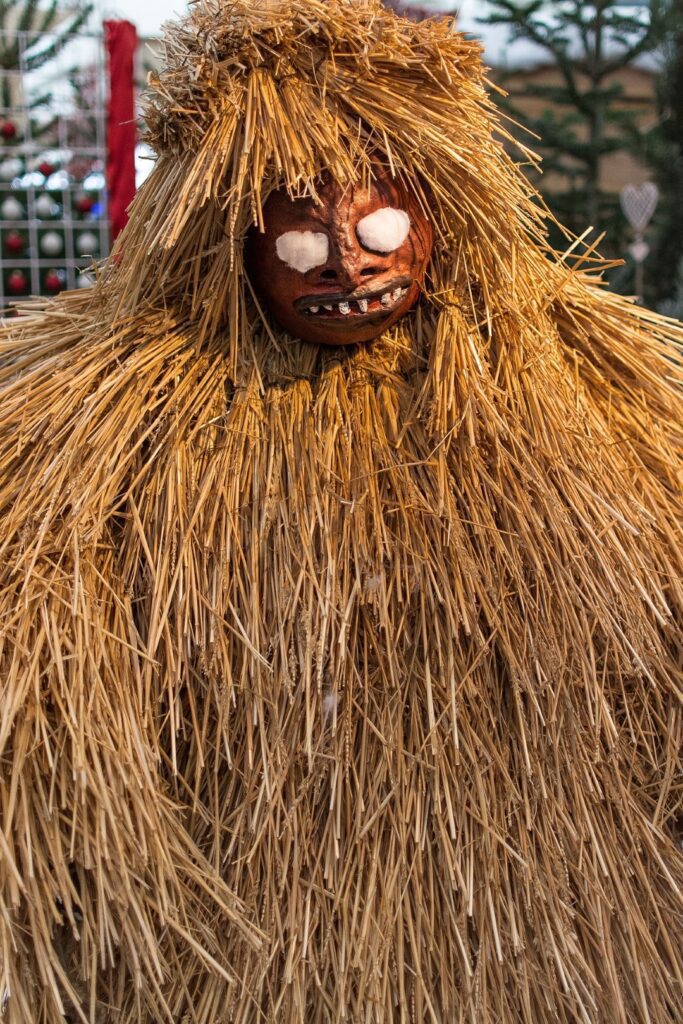
While the traditional Krampus (a half demon, half goat man) is probably the most well “known” of the German Christmas Demons, you can find even more authentic, cultural experiences in the heart of Bavaria. Depending on the region you are in, or even what tradition the locals are practicing, you may see several different names. Most are different dialects for Krampus, but some are even variations of the similar “theme” of the story of Krampus.
Some are not Krampus at all though and instead some really are ancient pagan celebrations to “scare away” the evil winter spirits (and not nothing to do with naughty children at all!).
Krumpus: What most people know him as.
Kramperl: This is an even more “Bayerisch” (Bavarian) term for Krampus.
Knecht Ruprecht: Knecht Ruprecht and Krampus are actually not the same, but the idea of scaring little children into behaving is similar enough and they are both “celebrated” on St. Nicholas Day. But Knecht Ruprecht is not a demon…just a really horrible bad guy who also loves to beat and steal naughty children.
Just like Krampus, Knecht Ruprecht tags along with St. Nick but instead of being Devil-like, this man is a bit more on the mischievous side instead of evil. Instead of terrifying wooden masks, Knecht Ruprecht is typically seen wearing a long robe with a pointed hat. He is more commonly found in areas around Franconia (Northern Bavaria), especially at places like the Nuremberg Christmas Market, which is often considered one of the Best Christmas Markets in Germany.
Belsnickl: Very similar to Krampus, Belsnickl (or Belsnickel) is more common in the Saarland region of Germany (the area that borders France)
Teufel: The word “Teufel” literally translates to “Devil!” Many different Pass or Bass groups will call themselves Tuefels (usually in conjunction with their town or region’s name)
Buttnmandl: Most common in the Berchtesgadenerland and come with a “Bass” (or group). However, in this region, you’ll almost always find at least 3 Buttmandl together along with 1 St. Nick and very often an Angel (The “Christkind”).
Percthen: Perchten also aren’t actually Krampus, but many times these creatures get easily confused with Krampus. I’ll talk more about Percthen below but there are two kinds of Pertcthen
- Schönperchten (good Perchten- they bring good luck and chase out evil spirits)
- Schiachperchten (“bad” Percthen- similar to Krampus)
*Percthen actually don’t traditionally come on December 5th or 6th, but instead during the “Rauchtnacht” which is a period between Christmas and the Epiphany (January 6th)- but let’s cover that more in a bit, because there are also Perchtenlaufen! (Runs/Parades)
What Does A Truly Traditional Visit by Krampus Look Like? (By the locals)
As I said above, many towns will have a Krampus “wreak chaos” at a Christmas market or even have their own Krampuslauf (run/parade).
But there is a small region in Germany with truly one of the most traditional, cultural experiences I’ve ever seen. One of the most popular areas for the German Krampus is in the Bercthesgadenerland (South East corner of Germany, bordering Austria, near Salzburg). It’s something one can truly only understand by experiencing it themselves. It’s an amazing insight into a foreign culture with strange customs and traditions.
Here, the tradition goes back to the 16th century, and even today, the charade of how the Krampus visits still lives on in the villages with the locals and families. While the legend of Krampus sounds terrifying to most foreign people, for anyone who grew up with this event in the Berchtesgaden, it’s actually somehow an incredibly special, magical night.
There’s an electric feeling in the air as the entire village prepares for the coming of the Krampus. A mixture of giddy excitement and nervous chills fills the atmosphere every 5th of December. Imagine the scene….
The Kramperl Gather
First, the Kramperl (or in Berchtesgaden, they are often referred to as Buttnmandl) gather atop the mountain to survey the valleys and lands below. It is an ominous site knowing that in just moments, these beasts will descend onto the village!
A traditional Berchtesgaden Bass will include at least 3 Krampus alongside St. Nicklaus, who is sure to keep those wildings in order.! There is often an Angel (usually the “Christkind”) that accompanies the Bass as well. So before the shenanigans can begin, the Bass will gather to say prayers, such as the Our Father, Ave Maria, and the Angel of the Lord. Traditionally, a farmer’s wife would bless them with holy water as St. Nicklaus and an Angel preside over the gathering.
As the darkness begins to fall over the land, children and families begin to hear the clamoring of cowbells from far above on the mountainside.
Krampus is near!
The Streets are Filled With Wildings!
Slowly, the large group of Krampus and Buttnmandl, wrangled by St. Nick and the Angel decend upon the town. It’s a sight unlike any other as they clamor from the snowy mountainside and begin to stampede the cobblestone streets of the Altstadt.
Children and families begin to run inside their homes and wait……
The Buttnmandl Go Home to Home
Next, the Bass goes from house to house. Yes. The demons come into the individual family rooms with children waiting nervously for them!
However, you can’t have a wild Buttmandl running amock inside your home now, can you!? So, when they arrive, it’s customary for the homeowner (and/or St. Nick) to shower the Buttnmandl with holy water to help tame them and then St. Nick DEMANDS the beast to rest!! They may sing a few songs or say some prayers next for good measure to really make sure the Buttmandl/Krampus know their place and behave.
St. Nicklaus Rewards the “Good Kids” On His List
Then, St. Nick pulls out his list of good deeds that the individual children have done. Yes, he really does have an actual book ready and prepared to read aloud what good deeds Sally has performed this year!! He’ll call on the kids one by one and read aloud from his book things that he “saw” them do that were kind or “good” behaviors that year. The kids also may sing a few songs or say some prayers next to really make sure they are on St. Nick and the Christkind Angel’s good side.
The Buttnmandl Find the Naughty Kids
Traditionally, St. Nick then hands out goodies of fruit and nuts and maybe some chocolate coins. For fun, the Buttnmandl will often find a “naughty” person in the family to “throw out in the snow” such as a giggling teenager or willing father. The whole Bass then moves on to the next house to do the whole performance again. It can take all evening and even throughout the following day (Dec 6th) to get through all the houses in the villages.
Oh, and for you women reading this, if you get whipped by Krampus, watch out, as it’s said that you’ll be extra fertile!
Tip: In many places (basically anywhere where you see the word “Run”) the spectacle of Krampus has taken on a whole touristic vibe. If you want a really genuine Krampus experience then it’s best to find a smaller, local village to experience an authentic Krampusnacht, such as in Berchtesgaden.
Frau Perchta: The Female Krampus? NEIN!
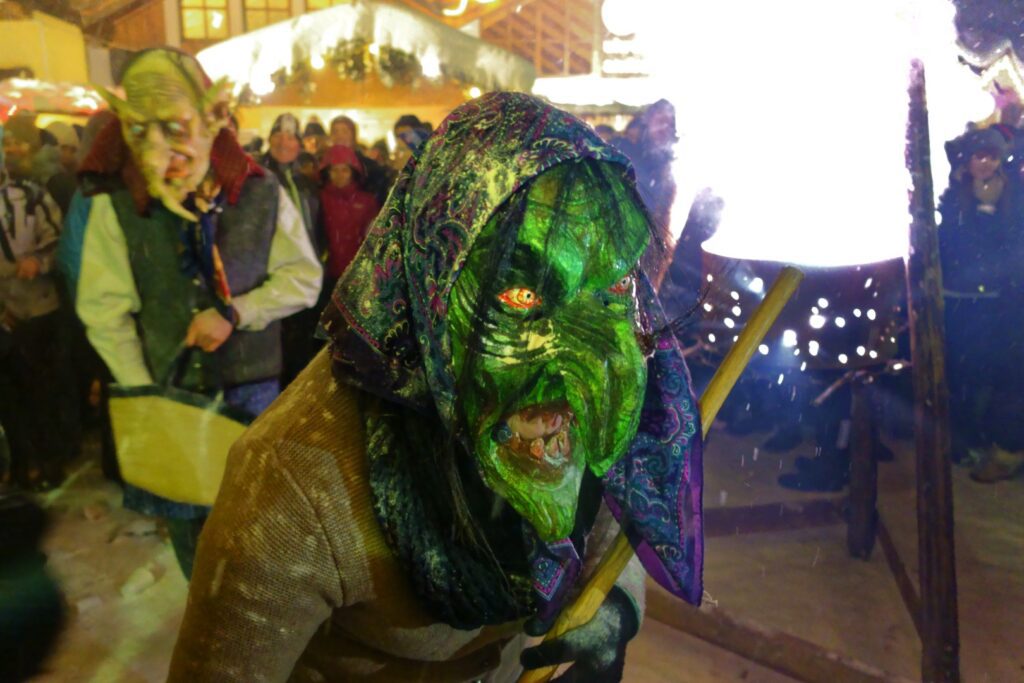
Frau Perchta is NOT the feminine version of Krampus. She is her own terrifying legend in and of itself. There are numerous stories, legends, and myths as to exactly who Perchta is though. In some places, she goes by Berchta or Bertha, and in others she is simply known as “Spinnstubenfrau” (Spinning Room Lady).
But who is Frau Perctha? Is she a Goddess? A “Christmas Witch?” A murderous old hag?
Well, that’s a whole other story as well. But just know that she is NOT Krampus. In fact, she doesn’t even come before Christmas. Traditionally, she is a witch who comes to inspect the cleanliness of your home before the Epiphany (January 6). If it’s not tidied, then be prepared to have your guts replaced with rocks.
(Seriously…why do the Germans have to go so hard!?)
However, the reason why she is often confused with Krampus is because today, many Germans combine both old spooky stories. After all, they both have deformed, ugly faces (you’ll know it’s Perchta though and not Krampus because her face looks more like a “witch” than a “demon”) and they both wreak havoc for people who haven’t been “doing as they are expected.”
There are even specific Perchtalauf which are typically between December 26th and January 6th. Many of these focus less on “scaring bad people” but instead look to drive out evil spirits to bring in the Spring!
Krampus FAQs
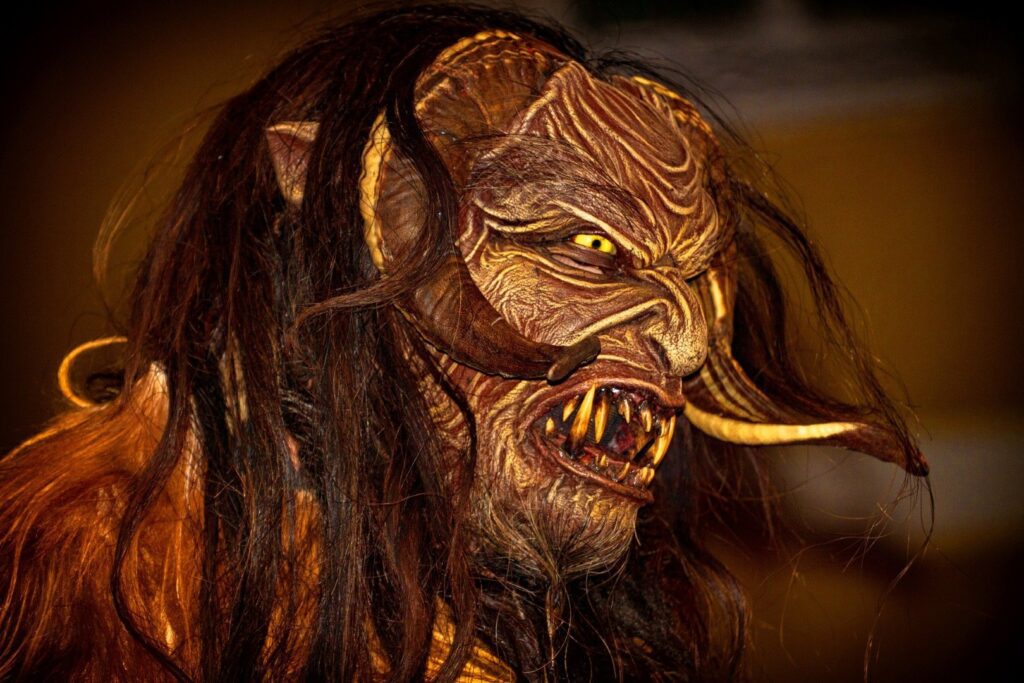
When is Krampusnacht?
December 5th
Is Krampus Real?
Krampus is a mythical figure created centuries ago. Today, Krampus is popular mostly only in Southern Bavaria and into Austria.
What does Krampus do to adults?
Krampus is less keen to steal adults away to his lair and eat them like he threatens children. Instead, he’s more likely to beat adults with his wooden rod. Giving adults a quick whip on their legs is a surefire way to “get them to behave.” However, it’s often believed that adults can tame a Krampus by offering him Schnapps!
Did Krampus originate in Germany?
Krampus is believed to originate in what is today’s Austro-Bavarian region, often referred to as Salzburgerland. This is the area that stretches both in Southern Bavaria and goes well into Austria.
Was Krampus banned in Germany?
Krampus is “alive” and well in Krampus today. However, there have been periods where it was banned, such as during the Inquisition when religious figures were afraid it was “celebrating the Devil” too much. The Nazi Regime also prohibited Krampus as well.
However, it is not banned today.
What does Krampus mean in German?
There are many different dialects and versions of the word, “Krampus.” However, the word Kramp (Krampen) is derived from the word”Claw” and it is believed that the old Bayerisch word “Krampn” means “Dead.”
Is Knecht Ruprecht the same as Krampus?
No. While both Knecht Ruprecht and Krampus tend to steal naughty children and beat them, Knecht Ruprecht is actually just a “mischievous man” whereas Krampus is half goat-half devil.
Merry Krampus, Everyone!
So, if you aren’t well versed on the Krampus Legend now as well as the traditional celebrations of it in Germany today, then the only thing left for you to do is to come experience a Krampusnacht yourself here in Bavaria! Give me a shout if you do!









